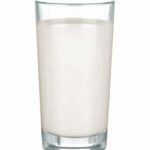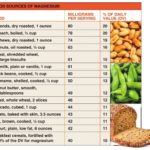
Natalie Digate Muth, MD, MPH, RD
Natalie Digate Muth, MD, MPH, RD
Article Archive
Plant‐based milks such as almond milk, soymilk, coconut milk, hemp milk and others seem to have wounded the pride of traditional milk providers. In January, a bill called the Dairy Pride Act was introduced in Congress. If passed, it would compel the Food and Drug Administration to enforce an existing guideline that limits use of the word "milk" to the products of hooved mammals like cows, sheep and goats.
Read MorePeople tend to forget about magnesium, but health experts increasingly recognize the key role it plays in boosting health. Magnesium is critical to muscle, nerve and heart function; blood glucose control; energy production; and bone structure.
Read MoreLooking for novel, nutrient‐packed foods to add to your diet? Fermented foods may be what you've been missing all your life. Known for their active bacteria and sour flavor, fermented foods improve blood sugar, blood pressure, eczema, digestive health, immunity and possibly even mental health and weight.
Dietary staples in cultures worldwide, fermented foods are gaining popularity in the United States amid a rising understanding of the health benefits of probiotics. Fermented foods include kefir, yogurt, kombucha, sauerkraut, miso, kimchi and tempeh.
Mexico's per‐capita consumption of soda is the highest in the world, which helps explain why public‐health advocates are so happy about the 2014 Mexican soda tax, which has helped shrink soda consumption by 7.6%. The 10% tax worked so well that Mexican nutrition advocates recently pushed to double the tax.
Read MoreOffering a mouthwatering array of fruits, from blood oranges and Asian pears to pomegranates and persimmons, a subscription to an "exotic fruit of the month club" may be the perfect way to keep the Mother's Day spirit alive all year. Sign her up and she'll get a delivery of nutrient‐packed fresh fruit each month, offering a constant reminder of your love.
Read MoreNegative stereotypes of people with obesity have painful consequences—especially if those people come to believe the stereotypes are true. Scientists call this weight‐bias internalization, and they have cause to worry about it.
Read MoreAmericans' notoriously unhealthy diets are seeing a few improvements, according to analysis in the Journal of the American Medical Association. Compared with a decade ago, consumption of fruits and vegetables, processed meat, saturated fat and sodium has not changed much. But Americans are eating more whole grains, nuts, seeds, fish and shellfish and drinking fewer sugary beverages. While 46% of adults still have poor diets, this is down from 56%.
Read MoreWeight bias (aka weight stigma) has been defined as “the social devaluation and denigration of people perceived to carry excess weight” (Tomiyama 2014). That sounds bad, and yet a majority of health, medical, allied health, and fitness and wellness professionals exhibit some degree of this stigma.
Read MoreAn adolescent with a parent who demands he "clean his plate" may lose his ability to respond to hunger cues and end up battling excess weight gain all his life. A working parent with a spouse who prepares calorie-dense, nutrient-poor meals for family dinners will struggle to maintain a healthy eating plan. But a child who grows up in a family where both parents are highly physically active is much more likely to be active himself.
Read MoreUndoing Weight Bias Within Yourself
10 steps that will help fitness and wellness professionals acknowledge and dismantle negative beliefs about obesity.
By Natalie Digate Muth, MD, MPH, RDN, FAAP
This article offers a 10-step process to help fitness and wellness professionals reduce their own biases toward people affected by obesity.
Read MoreTo people affected by obesity, there may be nothing more stigmatizing than walking through the doors of a fitness center and working with fitness professionals.
Weight stigma, also called weight bias—“the social devaluation and denigration of people perceived to carry excess weight” (Tomiyama 2014)—is so pervasive that it may well be the last form of widespread stigmatization that is still socially acceptable. What’s more, it triggers a vicious cycle of eating more and exercising less, leading to further weight gain (Tomiyama 2014).
Why it’s a great idea to start a walking program in your community, and how you can get moving on it.
Read MoreHealth and fitness professionals who join the physical literacy movement can play a powerful role in helping children become active for life. Here are several ways you can get started:
Read MoreSuccessful athletes have an abundance of ability, confidence and desire, the bulwarks of physical literacy, but pressuring youth to specialize too early in life can come at a cost.
Read MoreMotivational interviewing is a communication approach where a coach helps a client work through ambivalence toward behavioral change. It is highly effective for people who are ambivalent about change.
Read MoreFitness professionals can get a good sense of how ready a person is to change their behavior by using motivational interviewing’s “readiness ruler.” The ruler includes two questions aimed at understanding how important change is to a client and how confident the client is that he or she can make a change.
Read MoreThese excellent resources can help you get started with a career or business that includes nutrition coaching:
Academy of Nutrition and Dietetics (www.eatright.org). The site provides credible, evidence-based nutrition information and resources for health professionals and the public. Some fitness professionals who are not registered dietitians are eligible to join through the Academy’s affiliate membership program, which offers additional resources and benefits.
Read MoreHealth and fitness professionals are important players in a nationwide movement to promote and support physical literacy, which in turn will help to set the stage for a healthier, more active, more productive generation of children
hey’re doing either too little or too much.
For U.S. youth, that’s the stark paradox of physical activity. While
more than half of adolescents fail to accumulate the recommended 60
minutes of exercise at least 5 days per week (CDC 2015), many young
athletes are becoming specialized too early in life, which fosters a
culture of elite sports that discourages broad participation.
The active compounds found in these foods have been credited with helping to reduce pain, sometimes to the same extent as commonly prescribed nonsteroidal anti-inflammatory medications. Some of the studies—on humans and animals—into the role of these foods in pain management are promising, but the research is in its infancy.
Read More


















